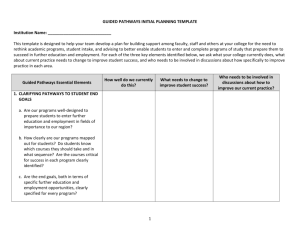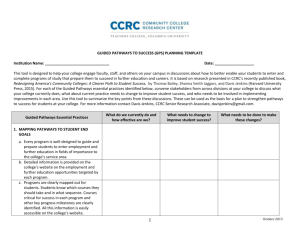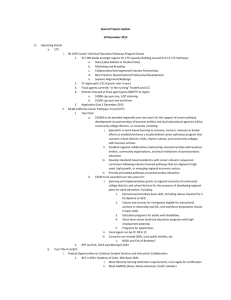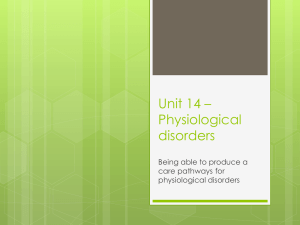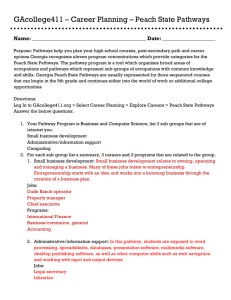FINAL-Talking-Points-for-All-Audiences_expanded
advertisement
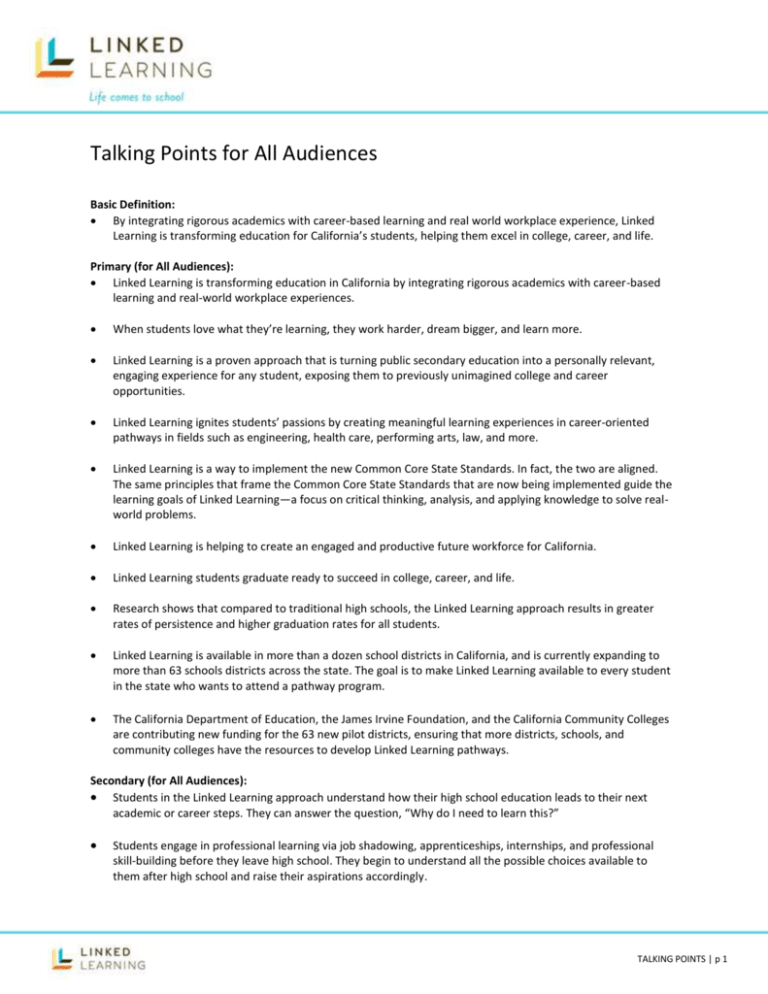
Talking Points for All Audiences Basic Definition: By integrating rigorous academics with career-based learning and real world workplace experience, Linked Learning is transforming education for California’s students, helping them excel in college, career, and life. Primary (for All Audiences): Linked Learning is transforming education in California by integrating rigorous academics with career-based learning and real-world workplace experiences. When students love what they’re learning, they work harder, dream bigger, and learn more. Linked Learning is a proven approach that is turning public secondary education into a personally relevant, engaging experience for any student, exposing them to previously unimagined college and career opportunities. Linked Learning ignites students’ passions by creating meaningful learning experiences in career-oriented pathways in fields such as engineering, health care, performing arts, law, and more. Linked Learning is a way to implement the new Common Core State Standards. In fact, the two are aligned. The same principles that frame the Common Core State Standards that are now being implemented guide the learning goals of Linked Learning—a focus on critical thinking, analysis, and applying knowledge to solve realworld problems. Linked Learning is helping to create an engaged and productive future workforce for California. Linked Learning students graduate ready to succeed in college, career, and life. Research shows that compared to traditional high schools, the Linked Learning approach results in greater rates of persistence and higher graduation rates for all students. Linked Learning is available in more than a dozen school districts in California, and is currently expanding to more than 63 schools districts across the state. The goal is to make Linked Learning available to every student in the state who wants to attend a pathway program. The California Department of Education, the James Irvine Foundation, and the California Community Colleges are contributing new funding for the 63 new pilot districts, ensuring that more districts, schools, and community colleges have the resources to develop Linked Learning pathways. Secondary (for All Audiences): Students in the Linked Learning approach understand how their high school education leads to their next academic or career steps. They can answer the question, “Why do I need to learn this?” Students engage in professional learning via job shadowing, apprenticeships, internships, and professional skill-building before they leave high school. They begin to understand all the possible choices available to them after high school and raise their aspirations accordingly. TALKING POINTS | p 1 Employers are critical partners in Linked Learning. Employers provide essential work-based learning opportunities for students. Students interact with professionals in California’s top industries in real-world settings and graduate with a clear understanding of what they need to do to be successful in any postsecondary education program or career. Linked Learning creates more opportunity for students to discover new aspirations and graduate with the skills and knowledge they need to succeed in college and career. Linked Learning improves equity for all California students. It inspires students who may never have imagined going to college to excel in high school, graduate, and succeed in college and life. Linked Learning prepares high school students for a full range of post-graduation opportunities. It combines academics and professional skills—which are both necessary for a complete education and a successful future. Improving educational achievement for all students will require the help of entire communities—including business leaders, parents, community organizations, and higher education—working together with educators as stakeholders in the public education of their communities. Secondary (for Educators): Administrators and School Board Members Ask any Linked Learning district superintendent, principal, or teacher and they will tell you about students who arrived in high school expecting not to attend college, but who quickly raised their aspirations as well as their achievement. Teachers working in Linked Learning pathways are energized, engaged, and enthusiastic. They collaborate with their peers, interact with the larger community, and are invested in their students’ success. The Linked Learning approach is an affordable and sustainable long-term investment in student success, even in the current fiscal environment. Studies have found that upfront investment in Linked Learning leads to benefits for the economy and taxpayers that far exceed the cost. While Linked Learning can benefit from additional resources, the districts already practicing Linked Learning prove that successful implementation can be achieved by reallocating existing resources. Linked Learning is flexible, adaptable, and can be tailored to the unique needs of most districts, schools, and communities. Linked Learning is a way to implement the new Common Core State Standards. In fact, the two are aligned. The same principles that frame the Common Core State Standards that are now being implemented guide the learning goals of Linked Learning—a focus on critical thinking, analysis, and applying knowledge to solve realworld problems. Because partnerships with employers and industry are essential for Linked Learning pathways, district leaders play a key role in building support and maintaining successful relationships with business leaders. Teachers Teachers working in Linked Learning pathways are energized, engaged, and enthusiastic. They collaborate with their peers, interact with the larger community, are invested in their students’ success, and are fully supported by their principals and districts. TALKING POINTS | p 2 Teachers already work hard to prepare students for better opportunities after high school. Linked Learning enhances those efforts and makes teaching more collaborative and enjoyable. It also offers students a more cohesive, engaging experience that inspires them to work harder. Linked Learning is a way for teachers to implement the new Common Core State Standards. In fact, the two are aligned. The same principles that frame the Common Core State Standards that teachers are working to implement guide the learning goals of Linked Learning—a focus on critical thinking, analysis, and applying knowledge to solve real-world problems. Linked Learning is flexible and adaptable and can be tailored to the unique features of most schools and classrooms. Linked Learning also allows teachers to align their curricula and classroom instruction to the Common Core because the principles that frame the new state standards are the same ones that guide the learning goals of Linked Learning—a focus on critical thinking, analysis, and applying knowledge to solve real-world problems. Many resources and tools are available1 from the Linked Learning Alliance, ConnectEd, the National Academy Foundation, and other organizations that can help teachers incorporate student-centered, project-based Linked Learning instruction aligned with career pathways. Secondary (for High School Students): Linked Learning gives you the opportunity to learn what you love, connecting your coursework with your interests and aspirations. Your Linked Learning education will help you decide what you want to do after high school, prepare you for the challenges of college and career, and make sure that you have the skills and knowledge to seize opportunities that come your way. Your pathway is part of the larger Linked Learning movement across the state. This movement is working to create a more engaging and relevant academic experience for all California students. Your voice matters. You can help expand Linked Learning opportunities to more students statewide by sharing your experience with policymakers, school officials, parents, and other students. Secondary (for Middle School Students): Linked Learning gives you the opportunity to learn what you love, connecting your school work with your interests and goals. Linked Learning will give you hands-on experiences in real-world projects in fields such as engineering, health care, performing arts, law, and more. Linked Learning will help you decide what you want to do after high school, prepare you for the challenges of college and career, and make sure that you have the skills and knowledge to seize opportunities that come your way. Linked Learning is a way for students to meet the new Common Core State Standards. In fact, the two are aligned. The same principles that frame the Common Core State Standards that are now being implemented in California schools guide the learning goals of Linked Learning—a focus on critical thinking, analysis, and applying knowledge to solve real-world problems. 1 Whenever this talking point is used, direct the audience to the available resources online, or include hyperlinks. TALKING POINTS | p 3 The Linked Learning pathway(s) at [SCHOOL NAME/IN THE NAME OF DISTRICT] are part of a larger Linked Learning movement across the state to make high school more relevant, and answer the question you’re always wondering…”Why do I need to know this?” Secondary (for High School Parents): Everyone should take time to decide their future, but too often, students are unaware of all the options and opportunities available to them. Linked Learning inspires students to stay in school, achieve more, and graduate ready for college and career. And, it helps students see the connection between education and life, answering the question, “Why do I need to learn this?” Linked Learning opens doors to more opportunities for your child after high school. By gaining real-world experience and skills in California’s top industries, Linked Learning students are highly employable and ready to succeed in their chose career path, whether they go straight into the workplace or go to college first.. Parents have an important role to play in creating Linked Learning pathways in their communities and advocating for expanded opportunities for their children. Parents should use their voices to tell educators that they want Linked Learning for their children and their community. Parents should encourage policymakers at the local and state level to support expansion of Linked Learning, and urge them to provide resources and funding to help schools create and expand the Linked Learning pathways offered to students. Secondary (for Middle School Parents): Everyone should take time to decide their future, but too often, our students are unaware of all the options and opportunities available to them. Linked Learning pathways are an opportunity to help your child explore their interests while developing the skills they will need for life after high school. Linked Learning is not about funneling your child into a set career path early in life. It’s about exposing them to real-world experiences to help them get a clearer sense of where they want to go and what they need to do to get there. Linked Learning helps students see a path for themselves, and then gives them the skills and knowledge they need to reach their goals. Secondary (for Business Leaders): California’s businesses need a better educated workforce to meet current and future demands. But right now not enough students are graduating high school, and those that do often lack the skills and knowledge to succeed in college and career. Linked Learning pathways are giving students more exposure to California’s major industries, giving them a better understanding of the types of career paths and jobs available, and helping them develop the skills and knowledge they will need to succeed. The Linked Learning approach invites employers to partner with schools to ensure that both the academic and professional learning curricula are preparing students to succeed in a career within the pathway’s field. Businesses can help invest in the future of their workforce by providing students in Linked Learning pathways with exposure to high-quality work-based learning programs from a variety of industries and sectors. TALKING POINTS | p 4 Secondary (for State Policymakers): By creating a workforce that is better equipped to succeed in postsecondary education programs and handle the jobs of the future, Linked Learning makes California more competitive and benefits the state’s businesses, tax base, and economy. The Linked Learning approach is an affordable and sustainable long-term investment in student success, even in the current fiscal environment. Studies have found that upfront investment in Linked Learning leads to benefits for the economy and taxpayers that far exceed the cost. Linked Learning is a way for the state’s schools to implement the new Common Core State Standards. In fact, the two are aligned. The same principles that frame the Common Core State Standards guide the learning goals of Linked Learning—a focus on critical thinking, analysis, and applying knowledge to solve real-world problems. Linked Learning pathways are an approach to learning within our public schools. They are not charter schools. Policymakers need to work together and with local communities to ensure that a favorable policy environment and funding are available to help expand Linked Learning opportunities for more students in the state. Secondary (for Local Policymakers): Linked Learning exposes students to real-world work-based experiences in their communities—helping to prepare the future workforce of the region and strengthen the community. The Linked Learning approach is an affordable and sustainable long-term investment in student success, even in the current fiscal environment. Studies have found that upfront investment in Linked Learning leads to benefits for the economy and taxpayers that far exceed the cost. While Linked Learning can benefit from additional resources, the districts already practicing Linked Learning prove that successful implementation can be achieved by reallocating existing resources. Linked Learning is also helping students meet the goals of the Common Core because the principles that frame the Common Core State Standards are the same ones that guide the learning goals of Linked Learning—a focus on critical thinking, analysis, and applying knowledge to solve real-world problems. Secondary (for Teachers Unions): Linked Learning provides many benefits for teachers, by providing them an enriching framework and approach that can help them fulfill their mission of helping all students succeed, and by offering a unique opportunity to work with other teachers and professionals outside of schools. Teachers working in Linked Learning pathways are energized, engaged, and enthusiastic. They collaborate with their peers, interact with the larger community, are invested in their students’ success, and are fully supported by their principals and districts. Linked Learning is a way to implement the new Common Core State Standards. In fact, the two are aligned. The same principles that frame the Common Core State Standards that are now being implemented guide the learning goals of Linked Learning—a focus on critical thinking, analysis, and applying knowledge to solve realworld problems. TALKING POINTS | p 5 While Linked Learning pathways have the same length school day, teachers in Linked Learning pathways have more time to plan and collaborate with colleagues to create a more enriching and rewarding classroom experience. Linked Learning pathways are an approach to learning within our public schools. They are not charter schools. Linked Learning allows teachers to align their curricula and classroom instruction to the Common Core because the principles that frame the new state standards are the same ones that guide the learning goals of Linked Learning—a focus on critical thinking, analysis, and applying knowledge to solve real-world problems. Secondary (for Potential Community Partners): We need the voices of community leaders, employers, industry leaders, and labor unions to help convince policymakers and other business leaders about the need for expanded Linked Learning opportunities. Secondary (for Higher Education): Linked Learning in high school is helping prepare more students to graduate high school prepared to take college courses without the need for remediation. The California Community Colleges share the commitment to better prepare young people for success in college, career, and life and support all efforts to create seamless career pathways that extend from high schools through certificate and degree programs, and into careers in industries important to California. Students who earn a community college degree or certificate nearly double their earnings within three years. However, only half of California Community College degree or certificate-seeking students ever complete that process, and the rate is much lower for African American and Latino students. This effort focuses on building community college pathways focused on specific industries with support for the transition from high school to college and ongoing academic support and student services while in college in order to ensure more students can complete a community college degree or certificate. Additionally, colleges and high schools are working together in new ways to build dual enrollment opportunities and to develop opportunities for new assessments, coursework and student support Secondary (about Common Core and Linked Learning): Linked Learning is aligned to the Common Core State Standards. In fact, the same principles that frame the Common Core State Standards guide the learning goals of Linked Learning—a focus on critical thinking, analysis, and applying knowledge to solve real-world problems. Linked Learning helps teachers and schools align their curriculum to the Common Core while still ensuring that all students are ready the day they graduate high school to succeed in college and career. By challenging students to think critically, work collaboratively, and solve complex problems, Linked Learning emphasizes many of the same skills the Common Core does. By engaging students in a deeper understanding of the world around them, Linked Learning helps students develop the knowledge that they need to be prepare for college and career. TALKING POINTS | p 6
